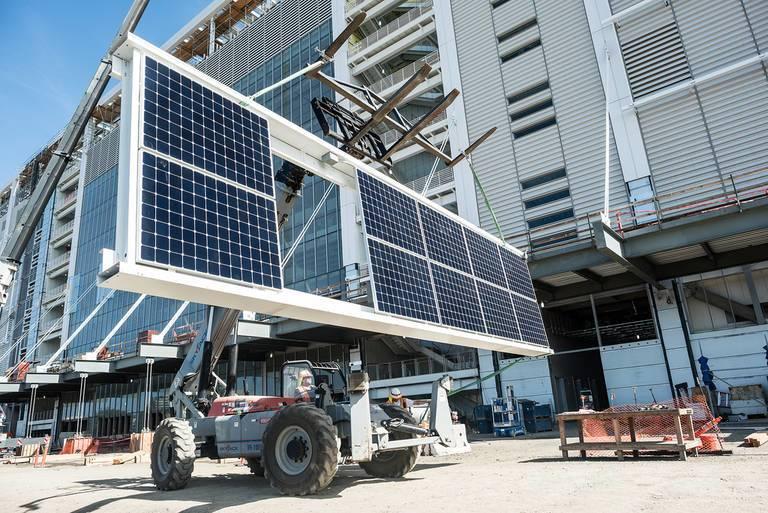
U.S. Energy Secretary Rick Perry is a vociferous fan of renewable energy, but in recent weeks he has gone out of his way to reinforce the Trump administration's promotion of large, centralized coal and nuclear power plants for electricity generation. That's despite the consensus among energy stakeholders, who are converging on distributed power generation and decentralized "smart" microgrids as the key to a resilient, reliable grid. Last week, NRG Energy Inc. Chief Executive Officer Mauricio Gutierrez provided some insights into how and why the Rick Perry power plan will not gain much traction outside of the coal and nuclear field -- nor even within it.
The Rick Perry power plan
For those of you new to the topic, last spring Perry raised eyebrows by assigning his agency to issue a report on grid reliability. The agency already has a sprawling grid modernization initiative well under way, and it is moving toward renewable energy and the decentralized, distributed electricity generation model. Nevertheless, a leaked memo from Perry indicated that the new study would be designed to justify the continued operation of conventional coal and nuclear power plants.
The study that finally did emerge was relatively consistent with the Energy Department's ongoing grid efforts. However, it has formed the basis of two recent proposals that Perry put forth. Both proposals are aimed at enabling coal and nuclear power plants to continue operating, even if less expensive options are available.
Though not stated in so many words, the Perry proposals would commit taxpayers and/or ratepayers to providing additional financial support for coal and nuclear power plants, which already benefit from significant public largess.
NRG speaks up for electricity options
The Perry proposals have met with significant blowback from energy stakeholders. Among the critics is NRG, a leading diversified energy company that also holds a good deal of coal fired power in its portfolio as well as natural gas and nuclear.
Last week NRG's Gutierrez sat down for an interview with Bloomberg that laid out the main issue.
In particular, Gutierrez addressed Perry's proposal to compensate coal and nuclear power plants that could demonstrate a 90-day supply on hand, as a means of ensuring continued operation in case of widespread outages.
Gutierrez described the Perry proposal as a "stink" bomb. On the plus side, it helped draw more attention to serious vulnerabilities in the nation's electricity grid. On the negative side, Gutierrez told Bloomberg that "specifically rewarding nuclear and coal-fired power plants, as Perry’s plan would do, isn’t the answer to ensuring a reliable U.S. power mix:"
What regulators need to do is define what makes a power plant “resilient,” he said, and then perhaps create a fuel-neutral, “resiliency market” in which all resources can compete to keep the lights on.
Gutierrez elaborated:
Whatever the commission comes up with needs to be fuel-neutral and markets-based, as opposed to depending on subsidies for specific power resources, Gutierrez said. “We cannot discriminate certain types of fuels,” he said, describing competitive markets as “the bedrock” of industries.
The non-discrimination argument doesn't just work for wind and solar. It also works for another one of NRG's major interests, natural gas. Stakeholders in the natural gas industry have actually joined with renewable energy companies to push back against Perry's plan. The basic argument -- presented by the American Petroleum Institute, for example -- is that natural gas is a cleaner, more flexible fit for the decentralized grid of the future.
With that in mind, NRG is focusing its future electricity generation efforts broadly on reducing carbon emissions. In an article published in Triple Pundit last summer, NRG head of sustainability Bruno Sarda made the case for focusing on the company's existing assets (emphasis his):
In 2014, we set industry-leading, science-based goals to reduce absolute greenhouse gas (GHG) emissions 50 percent by 2030 and 90 percent by 2050.These goals can only be met by reducing the carbon emitted by our conventional power generation assets – not by diluting our carbon profile through adding low-carbon assets like renewable generation and storage solutions.
Sarda further notes that the strategy -- which largely rests on converting coal units to natural gas -- is already proving to be effective, at least in terms of emissions from power plants (methane emissions attributed to drilling, transportation and storage are an issue yet to be addressed).
He also left the door open for a renewed focus on renewables and related clean tech:
New technologies are coming to the market regularly, so we don’t necessarily know all the additional levers that will emerge to help us meet these goals – but we’re already ahead of schedule and I like our odds of meeting or exceeding this goal by 2030.
Although NRG has adopted a source-neutral strategy for reducing its power plant emissions, customer demand is still engaging the company in renewable energy projects.
In the most recent development, health industry leader McKesson -- which ranks #5 on the Fortune 500 list -- has just partnered with NRG on a massive solar array for its Robbinsville, New Jersey distribution center. The 3-megawatt array is equal to almost 75 percent of the facility's electricity consumption.
Image: solar installation via NRG.

Tina writes frequently for TriplePundit and other websites, with a focus on military, government and corporate sustainability, clean tech research and emerging energy technologies. She is a former Deputy Director of Public Affairs of the New York City Department of Environmental Protection, and author of books and articles on recycling and other conservation themes.














